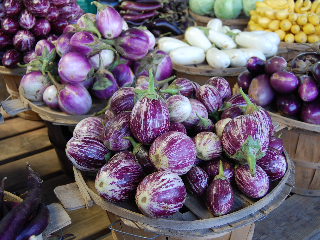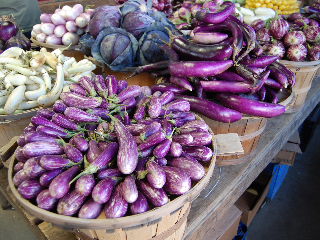
Eggplant is a member of the famous Solanaceae family of plants. Included in this grouping are the ever-popular tomatoes and sweet peppers.
Originally from India, eggplant is now cultivated virtually worldwide wherever temperate growing conditions allow.
It seems to be a somewhat “second tier” choice among home gardeners, certainly not enjoying the favor of the aforementioned tomatoes and peppers.
However, eggplant is easy enough to raise in your backyard garden if you so desire. Better results will be obtained if you start the seeds indoors in early spring and then transplant the young seedlings into your garden space after all danger of frost has past.
The plants are not overly demanding, requiring only the usual adequate sunshine, moisture, and a reasonably fertile and loose soil. A good organic mulch (or even layers of newspaper) will help maintain soil moisture as the season progresses.
The eggplants are subject to attack by a number of beetles and other insect pests. Watch for this and apply insecticidal soap spray or other produce-friendly deterrents if needed.
Many varieties exist from which to choose for your own gardening and harvesting experiment. Consult a good seed source (I like the Burpee© company and their Black Beauty variety) in procuring desirable eggplant varieties for your home garden.
As the eggplant starts to mature to usable size and ripeness, don’t wait too long to pick the fruit, as the overly ripe eggplants tend to become more tough and bitter. Pluck your pretty purple produce and head for the kitchen while its skin is still shiny and somewhat soft.
Eggplant can be prepared any number of ways, from stir-fry dishes to casseroles to baked entrees involving other vegetables, meats, or cheeses and spices. Being a native of India, eggplant is popular in curried dishes and responds well to seasonings (turmeric) and oils (olive oil) as well as other flavorings.
Eggplant is a good source of potassium and fiber in your diet, in addition to containing antioxidants that can help eradicate those possible cancer-causing free radicals.
One of those “good food/bad food, we’re not quite sure” debates concerns eggplant and its other nightshade neighbors that are sometimes thought to aggravate arthritis and other joint conditions in the human body. For this reason, some people choose to not incorporate the nightshades into their diet.

(On a personal note, I know one elderly lady who swore that her arthritis disappeared once she eliminated the nightshades from her diet.)
If you elect to eliminate the nightshades from your dining table, don’t fret. Plenty of natural and healthy nutrition can be found in other fruits and vegetables.
On the other hand, if you want to experiment with growing and cooking your own eggplants, have at it. Try several different varieties and several different recipes and see how they work for you.
And, while you’re at it, note that eggplant exists in a number of shapes, colors, and sizes. Have fun as you find your own path to better health!
 Eggplant is a member of the famous Solanaceae family of plants. Included in this grouping are the ever-popular tomatoes and sweet peppers.
Eggplant is a member of the famous Solanaceae family of plants. Included in this grouping are the ever-popular tomatoes and sweet peppers.
 (On a personal note, I know one elderly lady who swore that her arthritis disappeared once she eliminated the nightshades from her diet.)
(On a personal note, I know one elderly lady who swore that her arthritis disappeared once she eliminated the nightshades from her diet.)